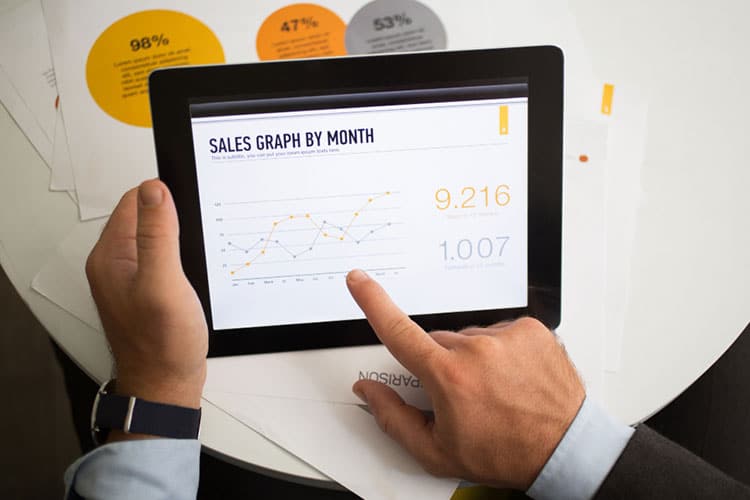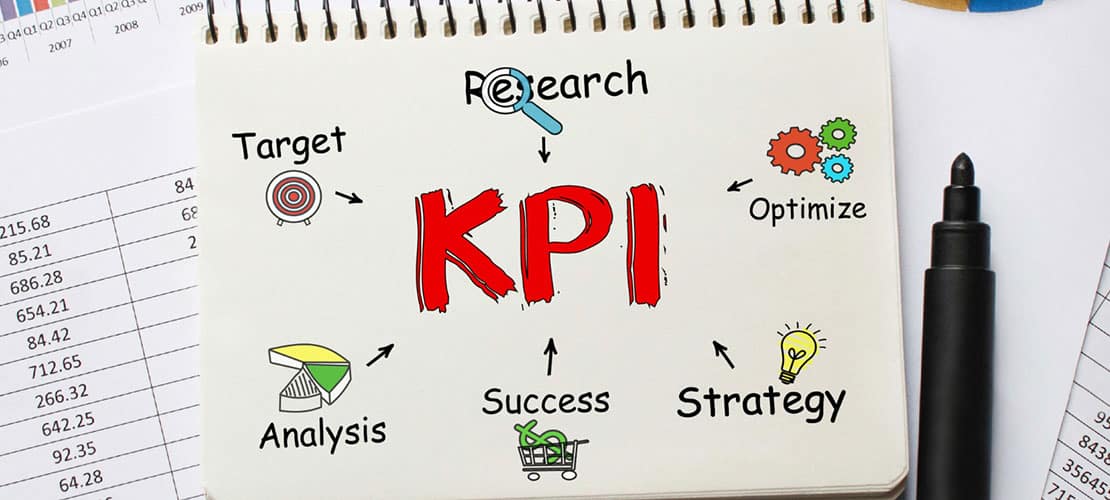There are several areas of your business that plays an important part in its overall success. Measuring each of these factors is crucial, as it allows you to have a clear view of how the business is doing. Tracking business-related data can also ensure you are able to detect problems before they happen and take action to prevent chaos or a significant loss.
One particularly important area that you need to monitor is your sales data. Without sales, your business would not have the ability to remain operational and turn a profit. This is why staff like sales reps are essential for your business, allowing you to attract customers for either products or services.
One of the most effective tracking and monitoring systems you can use is to focus on certain sales KPIs. By tracking sales KPIs, you are able to get a better view of your sales pipeline and how efficient it is. We will take a closer look at what sales KPIs you should keep track of in this detailed guide.
What Are Inside Sales KPIs?
We will start by taking a closer look at what sales KPIs are, with a particular focus on the key performance indicators related to your inside sales team. KPI is a term that refers to key performance indicators. These are metrics that you can use to determine the effectiveness of your sales teams and the particular strategies they use in order to generate leads and convert them into customers.
When you take a look at your sales teams, you may have both an internal and external setup. The sales team that focuses on external customer acquisition will work in the field. A sales rep may be asked to visit the customer on-site in order to close a deal.
The inside sales team, however, focuses on internal affairs that are associated with your sales process. These individuals consist of sales managers and sales reps. The sales teams that work internally will usually handle factors like lead conversion when the leads are obtained through emails, online forms, or other parts of your sales funnel.
Inside sales KPIs refer to the operations performed by these particular employees. You will usually have specific sales processes that you need your inside sales teams to follow. By tracking the inside sales KPIs, you are able to get a better idea of how well these strategies work. You can also use these sales KPIs as a way of determining who the top performers among the sales teams are and identifying a sales rep that seems to have poor performance when it comes to sales growth and working with qualified leads.
You can also use the data you collect through the capturing of sales KPIs in order to improve the strategies you use in the sales process. By looking at factors like how long it takes to close a deal, you can create a more realistic schedule and consider ways in which you can reduce this time or get more closed deals. These inside sales metrics can usually be tracked on the sales KPI dashboard that you use in your business.
What KPIs Should The Inside Sales Team Focus On?

The ability to identify the right sales KPIs to track is important. This ensures you can monitor sales performance without feeling overwhelmed with the data that you are presented with.
In this part, we are going to take a look at the important sales KPI metrics that you have to keep in mind while you monitor your sales and marketing teams. Each sales KPI plays a role in ensuring you know when sales opportunities arise, have a view of each customer’s value, and ensure qualified leads are dealt with in a timely manner.
While we focus on a large number of sales metrics in this section, it is important to still keep your business model in mind. You may only need to focus on some of these sales metrics in order to get a good overview of your sales performance. Taking a personalized approach to tracking sales targets, as well as monitoring the marketing and sales teams in your business, is the best way to go about the process.
Annual Contract Value
Understanding the value of every customer in your database is a crucial element when it comes to running a business. While you have a focus on converting qualified leads, it is important to track what existing customers bring to your business as well.
This is where the annual contract value comes into the picture. These sales metrics generally focus on determining the value of a customer’s contract over a period of 12 months. You will usually calculate the value based on your company’s financial year.
To calculate the annual contract value, you will first need to determine the total amount that the customer has paid on the contracts they have with you during this particular period. Then, you need to consider how many contracts you have had with the customer throughout the year. Divide the value by the number of contracts. This gives you the average annual contract value too.
There are different ways in which you can use the annual contract value of existing customers throughout your sales pipeline. For example, if you find that you are not close to your sales targets for a specific period, you can look at the annual contract value of different clients to determine potential opportunities. This can help you identify an opportunity for cross-selling or upselling – both of which can be very helpful when it comes to meeting the goals or targets that you set for your sales team.
When the annual contract value of existing customers seems low, then it is often an indication that there is a need to expand your list of clientele.
Customer Lifetime Value
Customer lifetime value is an important element that you need to keep in mind as well. When it comes to customer lifetime value, you will note that it has some similarities to the annual contract value. It also relates to the overall value that the customer poses to your business.
The difference is generally the time period you take into consideration with each of these KPIs. When it comes to determining the customer’s lifetime value, you will take a look at all of the contracts you have worked on for the client thus far. This will give you an overview of how much revenue the client has brought in for your business.
There are numerous reasons why it is important to track customer lifetime value. It is an excellent KPI to determine when you should provide a customer with a gift or voucher or follow up and express your gratitude for their loyalty. These are all matters that are exceptionally useful to ensure the customer remains loyal to your business.
You can also use the customer lifetime value statistics to determine who your most valuable clients are. The data allows you to determine if upselling to a specific client is a good idea at a particular point in time.
When you identify customers with a low lifetime value, it might be time to take a closer look at the customer acquisition cost associated with the client. Lower lifetime values also indicate opportunities in some cases. You can have your sales team focus on enhancing trust and loyalty among clients that have a low lifetime value. This can sometimes help to improve the sales metrics associated with the accounts of these customers.
Leads In Pipeline Average Age
You use your sales funnel to obtain leads. The sales team will then work on the leads that you are able to obtain with the funnel, according to instructions from the sales manager.
While these leads lie dormant in your pipeline, they are getting “cold.” This means that the longer it takes for your sales team to make contact with the lead, the lower the chances of closing a deal with them.
Having a good understanding of the average time and leads spent in your sales pipeline is very valuable. This also helps you better understand your current sales performance. When leads in the pipeline stay there too long, it could be an indicator as to why your sales data is lower than you expect it to be.
You can then use this data when you call a meeting with a sales manager. By presenting the data to them, the sales manager can implement the appropriate steps to ensure leads are dealt with faster. This will, in turn, help to reduce the average age of leads in your pipeline.
Conversion Rate
The performance of your sales team and the overall success of your strategies largely rely on the conversion rate that you are able to achieve.
Conversion rate refers to how effective your sales team is at converting a lead into a paying customer. A low conversion rate will often cause issues with your budget. If you do not convert a large number of leads into customers, then your marketing expenses might cost more than what the sales team is able to bring in.
There are different methods that you can use to identify the conversion rate of your campaigns. You should, however, ensure you have a system up that can provide analytical services for your sales funnel. Integrating this type of system with your client relationship management software makes it easier to get a good view of the conversions the sales team makes.
When you always have a view of the conversion rate of the marketing team and sales teams, then it is easier to understand when you need to make some changes. When you notice a fall in your conversion rate, then it is important to track the issue down to its cause. Consider why there has been a dip in sales and conversions, then try to rectify the problem that you identify. You can also refer to the conversion rate when you implement new marketing or sales strategies. When these strategies work well, you should find that the conversion rate also increases.
Customer Acquisition Cost
A business has many expenses – and a large amount of these expenses are made to acquire new customers. This is why it is important to thoroughly understand how much it costs your business to acquire a new customer.
Customer acquisition cost is the metric that you want to keep an eye on. This particular sales KPI tells you more about the expenses that occur in order to acquire one new customer.
Once you calculate the customer acquisition cost, you can start to compare it to other sales metrics that you have collected already.
A common strategy that businesses use is to compare the value of a customer to their acquisition cost. This can help you understand whether the revenue you generate from a customer provides efficient coverage for the expenses you had to undergo in order to obtain the client. When your acquisition cost is too high, then it is time to take a look at the strategy that the sales managers use, as well as consider strategies that could turn things around.
Customer Retention Rate
Many businesses do not only focus on the first sale they make to new customers. Once the customer signs the first contract, you want them to come back to your business when they are in need of services or products you offer.
This is where your customer retention rate comes in, which is another sales KPI that plays an important role in your business. Customer retention rate refers to how many clients you are able to keep on board compared to those who decide to move to a competitor over time.
There are several strategies that you can use to boost your customer retention rate. Each of these strategies plays its own role in ensuring you are able to get returning customers in order to drive better sales performance.
One strategy is to ensure your sales professionals are adequately trained on the products or services the business offers. When they show expertise while talking to a potential client, there is a great chance that the client will sign up. Once the client is onboard, you need to ensure your sales development reps offer each customer exceptional customer service. Friendly and professional customer service can go a long way in ensuring clients stay with you and do not go over to the competition in order to find staff that is able to give them a better service.
If you notice that your customer retention rate is low, then you will need to make a plan. Modern SAAS sales teams can usually work on strategies that are able to help retain more customers.
Rep Ramp-Up Time
Rep ramp-up time is something that many businesses overlook. This sales KPI, however, does play an important part in your business. It refers to the time it takes to get a new sales rep ready to start generating sales-qualified leads and work on the sales. It is important to ensure you track this period from the moment you decide to hire the new rep. The rep ramp-up time ends once the sales representative is able to boost the organization’s sales performance without assistance from the sales manager.
It is important to look at more than just the time it takes to “ramp up” the new hires in your company. You should also focus on identifying how much this costs you.
The idea here is to get the individual to the point where they can work with sales prospects as fast as possible. The idea is to boost the sales team’s performance – but also to keep your expenses as low as you possibly can.
When it takes a sales rep too long to get on board and ready to join the sales team members, it becomes costly for your business. At this point, you will need to consider the options that are available to you and whether or not continuing with the training and onboarding process is worth it.
Sales Rep Retention Rate
Apart from understanding the ramp-up time and rate related to your sales staff, you should also consider their retention rate. This is quite similar to the customer retention rate but rather focuses on internal staff instead of paying clients.
Sales rep retention rate generally refers to how well your business is able to keep reps working for it. When sales reps only stay for a short while, then you will need to do something about it. It is important to have a meeting with your sales and marketing team to get their view of the situation. Be sure to encourage open communication at this point. This can help you determine why sales reps leave, which is data you can then use in order to make improvements in your business.
Retaining sales reps for as long as possible is an important goal that every business should have. Every time you need to hire a new sales rep, it means they need to go through a ramp-up period. This takes time and would also result in no or little sales from the rep during this particular period. Thus, you want to keep the onboarding process for new sales reps at a minimal frequency and rather try to retain the employees who are already onboard.
Creating a more comfortable working environment is surely an effective strategy. This is especially important for high-growth companies. When you are dealing with an increasing amount of leads and sales, you have to ensure there is a sufficient number of people on hand to assist the new customers while also keeping existing clients satisfied.
Pipeline Growth
The pipeline that you use during the sales process plays a particularly important role in your business. Over time, however, the needs of your clients and sales personnel may change, so you need to ensure you regularly check up on the pipeline. Sometimes, the pipeline needs to grow, too, in order to accommodate new trends or other factors that make its current design less efficient.
Make sure you have a thorough understanding of how your entire pipeline works. Then, take a closer look at each step that the sales team follows as they work through the pipeline. Try to find areas where leads seem to be getting stuck. You have to focus on finding out what causes leads to lying in certain areas of the pipeline too long – as this could have an adverse impact on your company’s ability to meet its sales targets. High-growth companies need to pay special attention to the pipeline, as they may sometimes have multiple pipelines used due to the variety of products and services that they have to offer.
Sales Cycle Length
The length of the entire sales cycle is the next sales KPI that you should focus on. These important sales KPIs give you a better idea of how long it takes your sales team to go from lead to sale.
When you decide to track and monitor the sales cycle length, then there are a couple of things that you should keep in mind. First of all, make sure you track the cycle length from the moment a lead enters the database. This is when someone fills out a form on your sales funnel or perhaps when they send an email showing interest in your product.
The tracking starts now – and you have to follow the lead as it goes through the entire process. The moment the sale is marked as won or lost, this is when you stop tracking the cycle length.
Once you have some figures available after tracking multiple sales, then you can determine your average sales cycle length. Simply calculate all the time together and divide it by the number of sale cycles you considered during your assessment.
When you find that the sales cycle is too long, it is important to consider what changes you can make to your pipeline and funnel to convert leads to paying customers faster.
If you can speed up the process, you can usually get your paying customers multiplied as leads are processed and converted without any delays. It can be tough to identify the specific areas where you can speed things up, but take a look at how long it takes for your reps to make first contact with a prospect once they become a lead. When you have a low average response time percentage, then it is important to talk to your reps. Provide details about the sales rep’s performance and see if there is a way to speed this process up.
Strategies like gamification can also sometimes help to create a faster sales cycle.
Forecast Future Sales Accuracy
Forecasts are commonly used in modern-day business, as it provides managers and other authoritative staff the ability to have a view of what to expect in the coming months.
You will usually study historical data related to the sales campaigns you initiated in the past and your sales volume for the past years. This data is then compared to recent growth that was experienced in the business, and a forecast can then be calculated.
The process of making these forecasts is complex, so it is important to ensure the effort and time spent on them are not wasted. This is where the accuracy of your future sales forecast comes into play. The future forecast itself is also part of the KPIs you will likely track, but another key performance indicator relates to the accuracy of these forecasts.
Once the forecast is ready, it is time to compare it to real-world data. As time goes by, regularly revert back to the forecast that you compiled to determine if it is accurate and whether or not your business is doing as well as you expected it to do. The forecast doesn’t have to be accurate to the point, but it should at least align with your business’s performance during this phase.
Average Deal Size
Every sale you make will have its value and invoice attached to it. One customer might buy a service costing them $100 per month, whereas another requires services priced at over $1,000. This means that every deal does not bring in the same amount of revenue to your business, but it is still important to have an understanding of the average deal size.
The process of calculating the average deal size is not a complex process. In fact, if you have a CRM system for your business, you should already have the data you need to calculate the average deal size in front of you. You do need to consider the period over which you want to perform the calculation. Many companies and sales managers will choose to calculate the average deal size for a month, a quarter, or perhaps the entire year. It is also possible to use historical data to get an average deal size from when the business started to the current date.
Once you know the period you want to focus on the calculation, you need two figures. First is the total sale value over time, and the second is the number of deals you had. Divide the total sale value by the deal count, and then you have the average deal size. This gives you an idea about the average revenue you make with each deal. You can also use different customer segments when you calculate this factor.
The average deal size also gives you figures to work with when estimating future deals’ purchase value. It also plays a role in the calculation of the average profit margin for your business.
Sales Close Rates
Sales close rates relate to the conversion rate we covered previously, but there are a few differences between the two as well. A closed deal means you have successfully gotten the customer onboard, and they are now under the client list on your sales dashboard.
This particular rate tells you how many sales your team is able to close successfully and get customers onboard. You can use strategies like sales gamification on your sales dashboards to motivate your staff. This may help promote higher sales activities, positively influencing your inside sales metrics.
Lead To Opportunity To Sale Ratio
You need to calculate certain ratios when you look at the sales activities within your business. Start by looking at the lead-to-opportunity ratio. This refers to how many leads your sales team is able to take toward the opportunity stage in your pipeline. This is an important sales KPI and can help you get a better view of potential sales revenue your business is missing out on. At this point, the marketing manager has already created a channel to get the visitor to enter their details and convert them to a lead.
The next thing to calculate is the opportunity-to-sale ratio. Once a lead is marked as an opportunity, it means that they have shown interest in buying. This particular ratio tells you more about how well your sales staff are able to get these opportunities to sign and take the deal.
Are There KPIs That Don’t Matter?
When it comes to measuring sales KPIs and other business-related metrics, the more data you have, the better. With this said, it can be tough to filter through when you are faced with too much data. This is why you might want to ensure you only collect and focus on data that are critical to your sales process.
The sales KPIs that do not matter for a business really vary from one case to the next. You need to take a closer look at your business model, as this will play a large role in determining the most valuable sales KPIs and which will not provide you with significant value when analyzing data.
Keep in mind the industry you are in, the type of products and services you sell, the value of these items, and how your sales pipeline works.
While it is not critical to focus on every single sales KPI that exists, you should still ensure you collect all the data. This way, you still have data as a backup should you need to draw up a report when certain situations arise.
You can then prioritize the KPIs that you find most crucial to your business but keep the other sales metrics available on your database.
How Do You Track Inside Sales KPIs?
Data collection is a tedious task for most business owners. Traditionally, the sales team would record everything manually on paper and have it captured onto a system later on. Many businesses rely on systems like spreadsheet or database program, which involves a significant amount of manual effort from sales reps, accounting staff, and managers.
Fortunately, digital technologies make the process of monitoring sales efforts and related metrics much easier than in the past. There are several types of digital systems that you can use to help you keep track of customer data and sales metrics. Cloud technology has also evolved the way people use these systems. A cloud-first online system allows you to easily access your sales metrics and related data even when you are not at the office. With several automation systems in place, the process of capturing and sorting through data also becomes much easier and faster than before.
Not only do these systems allow you to capture data, but with several integration options available, you can often have the information automatically processed and sent to the right departments or apps. This eases the effort of the sales reps, allowing them to focus more on the sales process and enhance their own performance.
The Use Of A Sales Dashboard
CRM or client relationship management software is one of the most effective tools to keep track of your sales metrics. There are several CRM options on the market, so make sure you do some research to find one that works for you. HubSpot, FreshSales, and ZohoCRM remain some of the most popular options. All of these systems come with a free plan and a trial option. This can help you get started without having to add extra expenses to your business. As your company grows and your needs expand, you can then later decide to upgrade to a more powerful plan on these platforms.
Regardless of the CRM you choose, it is important to understand the different dashboards that make up the system. Each platform may have its terms for certain dashboards, but we will look at a general view of which dashboards should be provided to each authority in the sales process. Setting up different authority levels ensures every person only has access to information that is of use to them when they log into their CRM account.
Sales Leaders And Chief Revenue Officers
Sales leaders and the chief revenue officers in a company require a top-level view of everything that is related to the sales process. This is why you should offer these individuals access to a dashboard that provides a year-to-date report on the home page. The dashboard should only cover the most important sales metrics to ensure the CRO gains access to data they need to view without having to filter through a range of useless information.
Some of the factors that the CRO needs access to on their dashboard include:
- Overview of open and closed deals
- Deals are ordered by value, starting with the biggest valued deals at the top
- Quota attainment-based sales rep performance
- Overall performance of the sales process, compared to a forecast.
Sales Managers
Sales managers also need access to data that allows them to understand how the sales staff are performing. There are two important dashboards that sales managers require.
This includes a pipeline dashboard. The dashboard should provide details on the pipeline for every sales rep that is part of the team. Here, the manager can view factors like the sales cycle length, conversion rates, and average sale value for each sales rep.
A team activity dashboard is also important for sales managers. This dashboard provides a broader view of the entire team’s performance related to sales growth and efforts.
Sales Reps
Sales reps do not need to understand how the entire pipeline is performing and should only be given access to data that are related to themselves and the team they form part of.
A leaderboard dashboard is generally the best option for sales reps. This type of dashboard offers an overview of how each of the sales reps is performing. The dashboard shows all of the key sales metrics that are used to determine the ranking among the sales representatives.
Apart from providing these details, it is also important to ensure your employees can enter crucial data related to deals that they are working on. This will allow the sales rep to spend time directly on the dashboard in order to follow up on leads and convert them into sales. While the reps do not need access to inside sales metrics, they still contribute to the sales KPI data you can collect.
The Bottom Line
The sales process you use in your business is a crucial matter. Everything needs to work well together from the sales funnel to the sales team to ensure your business can continue to grow. It is important to track the right sales metrics consistently, as this ensures you always have your eyes on your business’s performance. Knowing what key performance indicators to track is also important, as it ensures you can monitor the team’s performance without wasting time. This also ensures you know how much revenue your business makes, observe the monthly sales growth, and gives you ability to identify sales opportunities early on.Spinify can help you boost your sales team’s performance and KPI tracking through our #1 Sales Gamification Platform. Book a free, personalized product tour today to find out more!



